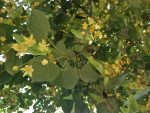 Also called American basswood, this medium to large deciduous tree is native to eastern US and southern Canada, and is a member of the mallow family, Malvaceae, that also includes hollyhock, cotton, and coffee. Trees are compact with a rounded crown and an upward branching habit. They have a deep spreading root system , gray to light brown, well fissured bark, and simple, coarsely toothed leaves that are oval to heart-shaped, dark green, 4-6″ long, and carried on long thin petioles. The star-like creamy-white flowers are less than 1/2″ across and appear in pendant branched clusters of 6-20 from the center of a long narrow leaf-like structure 4-5 ” in early to mid summer. The flowers are fragrant, attract bees, and are a good source of honey. The fruit is a round, gray-green nutlike fruit, up to 1/2″ long. American linden is long lived, valued for its shade, and makes a good street or lawn tree. It tolerates some drought but not air pollution or urban conditions. The genus name, Tilia, is the Latin name for the tree. The specific epithet, americana, refers to the geographic origin of the tree.
Also called American basswood, this medium to large deciduous tree is native to eastern US and southern Canada, and is a member of the mallow family, Malvaceae, that also includes hollyhock, cotton, and coffee. Trees are compact with a rounded crown and an upward branching habit. They have a deep spreading root system , gray to light brown, well fissured bark, and simple, coarsely toothed leaves that are oval to heart-shaped, dark green, 4-6″ long, and carried on long thin petioles. The star-like creamy-white flowers are less than 1/2″ across and appear in pendant branched clusters of 6-20 from the center of a long narrow leaf-like structure 4-5 ” in early to mid summer. The flowers are fragrant, attract bees, and are a good source of honey. The fruit is a round, gray-green nutlike fruit, up to 1/2″ long. American linden is long lived, valued for its shade, and makes a good street or lawn tree. It tolerates some drought but not air pollution or urban conditions. The genus name, Tilia, is the Latin name for the tree. The specific epithet, americana, refers to the geographic origin of the tree.
Type: Deciduous tree
Outstanding Feature: Foliage for shade
Form: Founded crown
Growth Rate: Rapid
Bloom: Tiny, star-like, fragrant, creamy white in pendent branched clusters of 6-20 in early to mid summer
Size: 40-80′ H x 30-50′ W
Light: Full sun but tolerates some shade
Soil: Fertile, moist, well-drained
Hardiness: Zones 2-8
Care: Prune occasionally to maintain shape
Pests and Diseases: Aphids, Japanese beetles,
Propagation: Cutting, layering, grafting; seed possible but very difficult.
Comments: Many cultivars are available that vary most significantly in form.
Photo Credit: Fritzflohrreynolds Wikimedia